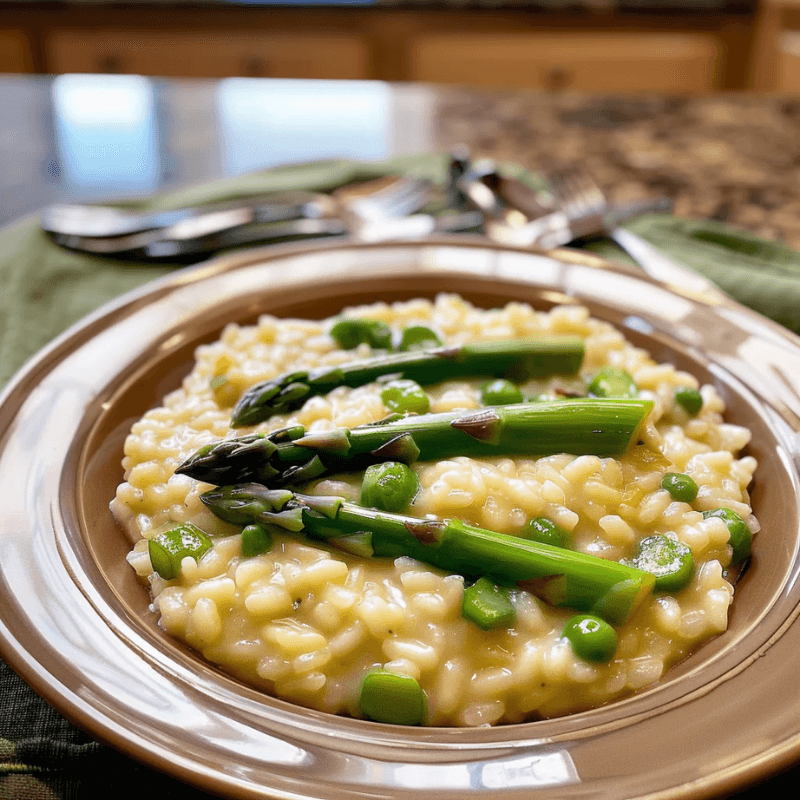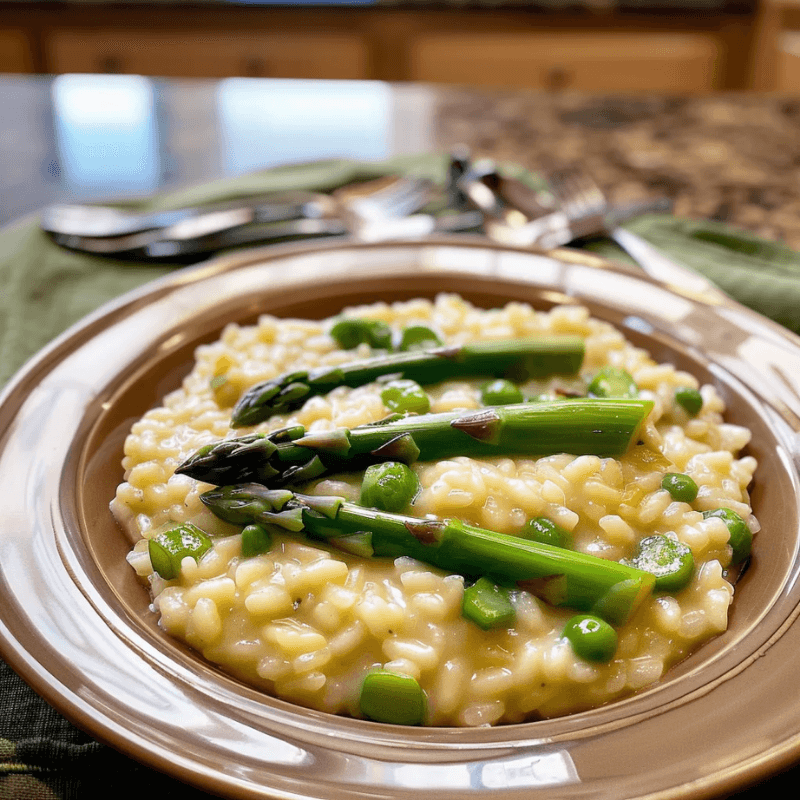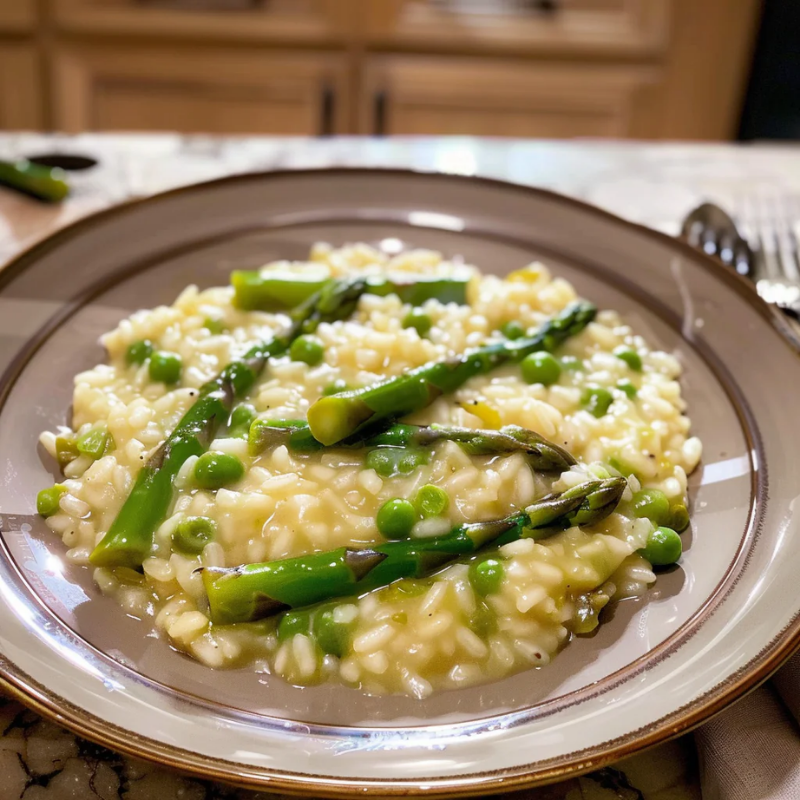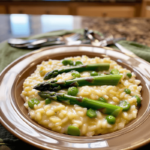Spring brings asparagus risotto to the forefront of Italian cuisine, with fresh asparagus available for less than $2 a pound. While this creamy dish appears deceptively simple, we’ve discovered that achieving restaurant-quality results requires mastering a precise 20-25 minute process of gradual stirring and broth addition.
In fact, this versatile dish serves beautifully as both a main course and side dish, offering a hearty yet light profile at 408 calories per serving. We can enhance its creamy texture with various additions like lemon zest or fresh herbs, making each bowl uniquely satisfying.
We’re about to reveal the essential techniques Italian chefs use to transform simple ingredients into the perfect asparagus risotto. From selecting the right stock to mastering the crucial stirring method that releases the rice’s natural starches, we’ll guide you through every step of creating this springtime classic.
The Secret Ingredient Italian Chefs Never Skip
Many aspiring home cooks overlook the cornerstone of exceptional asparagus risotto—the stock. After perfecting my risotto technique over years, I’ve discovered why Italian chefs place such extraordinary emphasis on this foundation ingredient.

Why stock quality makes or breaks your risotto
The stock you choose isn’t just background flavor—it’s the soul of your asparagus risotto. Quality stock directly impacts the starch content release, which determines whether you’ll achieve that signature silky texture with an al dente core.
When preparing asparagus risotto, remember this crucial ratio: one cup of rice requires approximately two and a half cups of stock. For a four-cup portion of arborio rice, you’ll need about four cups of stock. This precise balance ensures proper hydration without drowning the rice.
Additionally, the stock’s flavor profile must complement rather than overshadow your risotto’s star ingredients. Many professional chefs caution against using overly bold stocks that can mask the delicate flavor of asparagus. As one Italian chef notes, “Rice absorbs flavor. So if you use a bold, flavorful stock when making risotto, you’re going to taste it. And maybe only it”.
Homemade vs. store-bought: What chefs recommend
When it comes to asparagus risotto, authenticity often begins with homemade stock. Traditional Italian chefs insist on “stock ‘fatta in casa’ (homemade stock) whether it be chicken, veal or vegetable to enhance the risotto never mask it”. This approach allows you to control flavor intensity and complement the grassiness of asparagus.
For homemade options particularly suited to asparagus risotto, consider:
- Light vegetable broth made from leftover root ends and vegetable scraps
- Parmesan broth (simmering Parmesan rinds with onion and garlic)
- Diluted stocks (half water/half stock) to prevent overpowering the asparagus
Interestingly, some chefs even recommend using just salted water for certain risotto variations, adding concentrated flavors like pureed vegetables right before the rice finishes cooking. This technique works beautifully with asparagus, allowing its fresh spring flavor to shine.
For store-bought alternatives, seek lighter options without overwhelming flavors. Although convenient, these typically contain preservatives and higher sodium levels that can interfere with the subtle taste of fresh asparagus.
The perfect temperature that changes everything
Perhaps the most overlooked yet critical aspect of stock use is its temperature. Professional Italian chefs emphasize that stock must always be warm or hot when added to risotto—never cold.
Cold stock creates several problems. First, it “takes longer to warm up in the pan and may even shock your grains into holding onto the starch instead of releasing it while it continues to cook”. This prevents achieving that enviable creamy consistency that defines perfect asparagus risotto.
Furthermore, adding near-boiling stock creates the essential sizzle when it hits the rice. This momentary increase in temperature helps to “coax more starch out of each grain of rice”, providing that luscious mouth-feel without resorting to cream or excessive butter.
Another benefit of properly heated stock is maintaining consistent cooking temperature throughout the process. The risotto should remain at a medium simmer for the entire cooking time of approximately 16-20 minutes. Too low, and the stock absorption becomes sluggish; too high, and you’ll find rice stubbornly stuck to your pan.
By respecting these temperature principles, you’ll notice your asparagus risotto develops that restaurant-quality texture without needing additives to artificially enhance creaminess.
Mastering the Rice Selection for Authentic Asparagus Risotto
The choice of rice is the foundation upon which every authentic asparagus risotto is built. During my culinary journey through northern Italy, I learned firsthand that selecting the right grain directly determines whether your risotto achieves restaurant-quality excellence or falls disappointingly flat.
Carnaroli: The chef’s preferred choice
Professional Italian chefs overwhelmingly reach for Carnaroli when crafting perfect asparagus risotto. Often called the “king of Italian rice,” this relatively young variety (first bred in 1945 from Lencino and Vialone Nero parents) has earned its royal status for good reason. Carnaroli’s exceptional ability to maintain firmness even after prolonged cooking makes it uniquely suited for risotto’s 20-25 minute preparation process.
What truly distinguishes Carnaroli is its superior starch composition. This crucial attribute allows it to develop that coveted creamy texture without crossing into mushiness. As renowned chef Gabriele Boffa explains, Carnaroli “maintains a good resistance to overcooking and offers a very pleasant grain structure under the teeth”.
Moreover, this premium rice variety absorbs flavors beautifully without losing its structural integrity—essential when working with delicate asparagus notes that can easily be overwhelmed.
Arborio and alternatives: When to use them
Despite Carnaroli’s superiority, Arborio remains the most commonly used risotto rice in home kitchens. This shorter-grained option contains high starch levels that contribute to a “thicker, softer” finished dish. I’ve found Arborio particularly forgiving for beginners since it’s less likely to remain undercooked.
Arborio has become many home cooks’ default choice primarily due to accessibility and price point. It’s readily available in most grocery stores and typically costs less than specialty varieties like Carnaroli.
Beyond these two main contenders, several worthy alternatives exist:
- Vialone Nano: A medium-high starch content rice from Veneto that requires constant stirring for optimal results
- Baldo: Strikes an excellent balance between starchiness and firmness
- Acquerello: A premium aged Carnaroli with enhanced flavor from a special aging process
Nevertheless, avoid using long-grain varieties like jasmine or basmati, as they lack sufficient starch to achieve proper risotto consistency.
How grain size affects creaminess
Understanding the science behind risotto’s signature texture reveals why grain selection matters so dramatically. Not all rice varieties contain equal amounts of amylopectin—the branched starch molecules responsible for risotto’s creaminess.
Short-to-medium sized grains with rounded shapes typically contain ideal starch levels while remaining durable enough not to break apart during cooking. This combination creates the perfect balance of al dente center with creamy exterior that defines exceptional asparagus risotto.
Proper technique further enhances these inherent qualities. Initially, I toast the rice until translucent to seal in starch—a light parboilization process that ensures uniform cooking. Subsequently, adding liquid gradually allows for controlled starch release, culminating in a risotto that’s “all’onda” (wavy) when the pot is shaken.
Ultimately, regardless of which variety you select, never rinse risotto rice before cooking. This common mistake washes away surface starches essential for achieving that luxurious, velvety texture that makes asparagus risotto so irresistible.
The Stirring Technique That Creates Perfect Texture
One of the most persistent myths surrounding asparagus risotto involves constant, unrelenting stirring. Throughout my culinary exploration of authentic Italian techniques, I’ve discovered this widely-held belief needs serious reconsideration.

The science behind releasing rice starches
Contrary to popular wisdom, the creaminess in asparagus risotto comes primarily from the rice’s natural starch content—not from constant agitation. When rice grains rub against each other, they release amylopectin, the starch component responsible for that velvety consistency we crave.
Experts have conducted revealing experiments to test this theory. After soaking rice to remove surface starch, they prepared two batches—one with constant stirring and one with minimal intervention. The surprising result? Both achieved similar creaminess levels. This confirms that most starch releasing the creamy texture exists on the rice’s surface from the beginning of cooking.
Notably, this is precisely why we never rinse risotto rice before cooking—doing so would wash away those valuable surface starches. The toasting step also plays a crucial role, as it “coats the rice grains with a film of fat and controls starch release, allowing grains to remain intact during cooking and preventing them from becoming soggy”.
Common stirring mistakes home cooks make
Throughout my risotto-making journey, I’ve observed several critical errors that consistently undermine texture:
- Over-stirring: Excessive agitation introduces too much air into your asparagus risotto, cooling it down and creating a gluey consistency. As one Italian chef emphasizes, it’s “much better to stir once every 30 seconds and trust the cooking process to do its thing”.
- Under-stirring: Conversely, neglecting your risotto entirely leads to uneven cooking and rice sticking to the pan. With asparagus risotto especially, this can result in scorched rice that overwhelms the vegetable’s delicate flavor.
- Inconsistent temperature: Maintaining a medium bubble is essential—too low, and absorption stalls; too high, and rice sticks stubbornly to your pan.
- Failing to test doneness: The perfect asparagus risotto should be primarily soft with just a slight bite—softer than al dente pasta but still maintaining structural integrity.
When to stir and when to rest
Finding the perfect balance between stirring and resting is the key to mastering asparagus risotto. Generally, stirring serves two primary purposes: preventing sticking and ensuring even cooking.
The ideal approach? Stir occasionally—approximately once every 30 seconds. This allows enough movement to prevent sticking while trusting the cooking process to develop texture naturally. With proper heat, the rice continues moving independently between stirring intervals.
To determine when your asparagus risotto needs attention, use this chef-approved test: run your wooden spoon across the bottom of the pot. If little to no liquid remains, it’s time to add more stock. This visual cue proves more reliable than rigid timing.
The truth about cooking vessel choice also impacts stirring needs. Using a wider, shallower pan creates a more even layer of rice, reducing the necessity for constant stirring. Therefore, if you find yourself stirring excessively, consider your cookware—a proper risotto pan makes achieving perfect texture significantly easier.
Ultimately, perfect asparagus risotto requires finding that sweet spot where the rice achieves what Italians call “all’onda”—a wave-like consistency that flows when the pan is gently shaken. At this stage, the grains maintain their integrity while swimming in creamy, starch-enriched liquid—creating that legendary texture that makes asparagus risotto so irresistible.
Asparagus Preparation Secrets for Maximum Flavor
Properly prepared asparagus makes the difference between an ordinary risotto and an extraordinary one. After mastering stock selection and stirring techniques, I’ve found that the way you handle this spring vegetable itself determines the depth of flavor in your final dish.
The blanching method Italian chefs swear by
Italian chefs almost universally recommend blanching asparagus prior to incorporating it into risotto. This crucial technique starts with bringing approximately 8 cups of water to a rolling boil, then adding 2 tablespoons of kosher salt. After trimming your asparagus, submerge it in the boiling water for precisely 3-4 minutes.
Yet what truly sets professional preparation apart happens next – immediately transfer the asparagus to an ice bath, which halts the cooking process instantly. This “shocking” method preserves the vibrant green color while ensuring that perfect crisp-tender texture remains intact. I’ve discovered this technique eliminates the common problem of dull, overcooked asparagus that plagues many homemade risottos.
Timing asparagus addition for optimal texture
Even perfectly blanched asparagus can lose its charm if added too early in the risotto-making process. The ideal approach involves adding your prepared asparagus with the final addition of broth. This strategic timing prevents overcooking while allowing the vegetable to share its flavor with the rice.
For optimal texture contrast, reserve the tips separately from stalks, as they require less cooking time. The delicate tips need just 2 minutes of blanching compared to the 3 minutes required for stalks.
Using the entire asparagus stalk effectively
Contrary to common practice, exceptional asparagus risotto utilizes the entire spear. For risotto specifically, medium-thick or thick spears yield superior results. The preparation method below maximizes flavor from every part:
- Break off woody ends but don’t discard them
- Simmer woody ends for 10 minutes, then squeeze their juices back into the cooking liquid
- Cook stalks for 3 minutes in the same water
- Flash-cook tips for just 2 minutes
- Blend cooked stalks with cooking liquid to create an asparagus stock
This comprehensive approach elevates your asparagus risotto by infusing it with concentrated vegetable essence throughout the cooking process. Additionally, save a few blanched tips for garnishing your finished dish, creating both visual appeal and textural contrast.
The Finishing Touches That Elevate Your Asparagus Risotto Recipe
The final minutes of asparagus risotto preparation represent the critical difference between good and extraordinary results. After mastering earlier steps, it’s this finishing stage—known as “mantecatura”—that gives your dish that restaurant-quality magic.

The mantecatura method explained
Mantecatura comes from the Italian verb “mantecare,” referring to the technique of creating a homogeneous, smooth mixture by adding fats at the end of cooking. This crucial process happens off the heat with the addition of cold butter and cheese, while stirring from bottom to top with a wooden spoon.
For optimal results, move the pan back and forth to create what Italians call “Risotto all’Onda” or “Wave Rice”. The thermal shock between hot rice and cold butter releases buttermilk that produces the signature soft consistency. This contrast is vital—cold butter (ideally from the freezer) meets hot rice to create the silkiest emulsion.
Cheese selection and incorporation
Your cheese choice significantly impacts the final flavor profile. Classical options include:
- Parmigiano-Reggiano or Grana Padano for depth and umami
- Mascarpone for exceptional creaminess
- Pecorino for sharper flavor
Fold your selected cheese into the risotto immediately after removing from heat. For asparagus risotto specifically, mascarpone creates exceptional creaminess while maintaining the vegetable’s delicate flavor.
Balancing acidity with lemon and wine
Acidity works as a culinary spotlight, making other flavors “come alive”. A finishing squeeze of fresh lemon juice brightens the entire dish. Meanwhile, white wine incorporated earlier provides backbone acidity that cuts through the richness.
Pairing wine with asparagus risotto requires consideration—opt for wines with good cleansing acidity like Vermentino, Verdicchio, or Sauvignon Blanc.
Final seasoning adjustments
The last crucial step involves careful taste adjustment. Add salt progressively, tasting between additions. Fresh herbs like chives or dill (2 tablespoons) introduce brightness. Lemon zest provides aromatic citrus notes without additional acidity.
Finally, assess consistency—perfect asparagus risotto should be loose enough to “flip over itself in a dramatic wave-like motion”. If needed, add another small ladleful of hot broth to maintain this ideal texture. Always serve on warmed plates to prevent premature thickening.
Conclusion
After years of perfecting asparagus risotto alongside Italian chefs, I’ve learned that excellence lies in mastering these essential elements. Quality stock serves as the foundation, while properly selected rice creates the perfect canvas. Though many believe otherwise, occasional stirring proves more effective than constant agitation.
Blanched asparagus, thoughtfully prepared and added at the right moment, brings springtime freshness to each bowl. The final mantecatura transforms good risotto into something extraordinary – creating that signature wave-like flow that marks authentic Italian preparation.
Remember that perfect asparagus risotto requires patience and attention to detail. Start with these techniques, and you’ll soon create restaurant-quality results that showcase both the creamy comfort of risotto and the delicate flavor of fresh asparagus. Each element builds upon the last, resulting in a dish that’s both technically precise and wonderfully satisfying.

Welcome to HealthyBlog365, your go-to destination for all things food and drink. We believe that every meal is not just a way to nourish your body but also a meaningful connection with yourself and your loved ones.
HealthyBlog365 was created with a mission to inspire healthy living through nutritious meals and refreshing beverages. Here, you’ll discover a treasure trove of creative recipes, kitchen tips, and healthy eating trends tailored to fit modern lifestyles.
 What can you find on HealthyBlog365?
What can you find on HealthyBlog365?
- Delicious and easy-to-make recipes: From simple meals for busy mornings to wholesome dinners for family gatherings, we’ve got you covered for every occasion.
- Nutritious drinks: Explore recipes for juices, smoothies, detox teas, and drinks that cleanse your body, boost your mood, and energize your day.
- Guides on eating habits: Get detailed insights into popular diets like keto, low-carb, and vegetarian-friendly meal plans.
- Kitchen hacks: Discover smart tips to save time, preserve food, and cook more efficiently.
We are committed to providing high-quality content, staying up-to-date with the latest trends, and maintaining a balance between nutrition and flavor.
 Connect with HealthyBlog365 on Social Media
Connect with HealthyBlog365 on Social Media
Join the HealthyBlog365 community on social media platforms to stay updated with our latest posts, watch exciting tutorials, and share your food stories with us:
Facebook: Follow us here to stay updated with our latest posts and join our community.
Instagram: Check us out here for inspiring visuals and ideas.
Pinterest: Pin with us here to save creative ideas you’ll love.
YouTube: Subscribe here for detailed tutorials and exciting videos.
 Thank You for Supporting HealthyBlog365!
Thank You for Supporting HealthyBlog365!
We aim to build a connected community where everyone can share and learn from each other. If you have any questions or suggestions, don’t hesitate to reach out to us via social media or our website.
We hope you have a wonderful time on HealthyBlog365 and find new inspiration for your healthy culinary journey!

Asparagus Risotto
Description
Ingredients
- 1 cup Arborio rice
- 2 cups fresh asparagus chopped
- 4 cups vegetable broth low-sodium preferred
- 1 cup freshly grated Parmesan cheese
- 1 medium onion finely chopped
- 2 cloves garlic minced
- 2 tablespoons extra virgin olive oil
- Salt and pepper to taste
Instructions
- Gather and prepare all ingredients by chopping the asparagus and finely dicing the onion and garlic.
- In a large skillet over medium heat, add olive oil. Once hot, sauté the onions until translucent (about 3-4 minutes), then add garlic and cook for an additional minute.
- Stir in Arborio rice and cook for about two minutes until slightly translucent.
- Gradually add warm vegetable broth one ladle at a time while stirring frequently until absorbed. Continue this process for about 18-20 minutes until the rice is al dente.
- Fold in the chopped asparagus during the last five minutes of cooking. Remove from heat and stir in Parmesan cheese until melted.
- Serve immediately, garnished with extra Parmesan or fresh herbs if desired.
